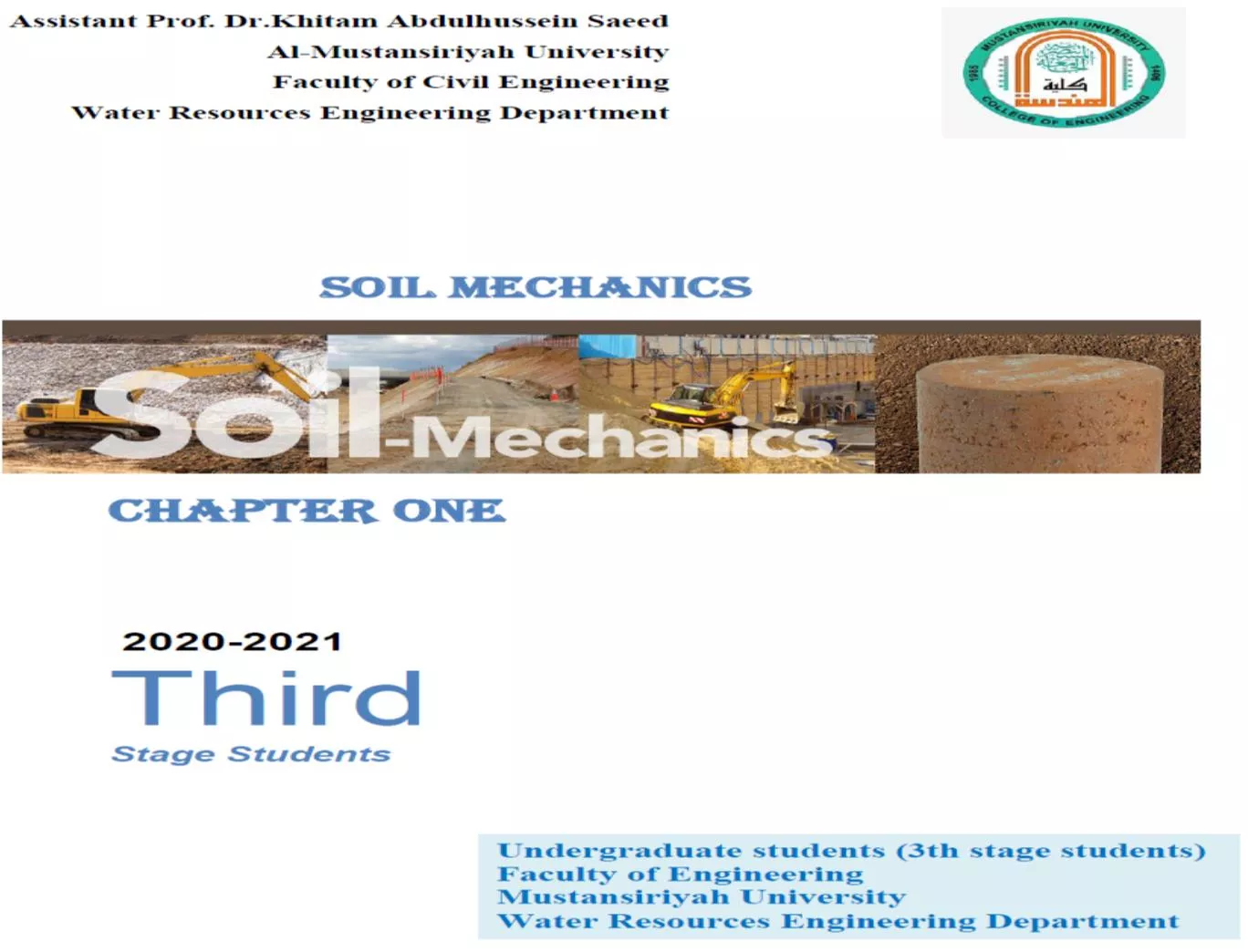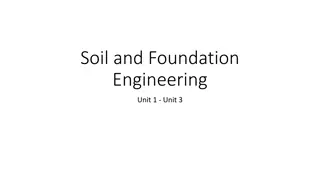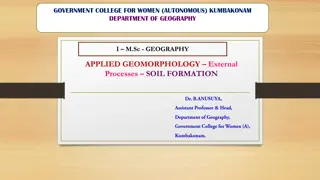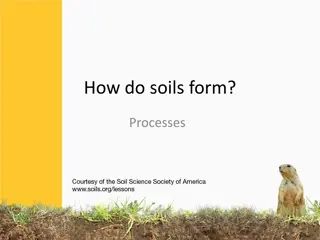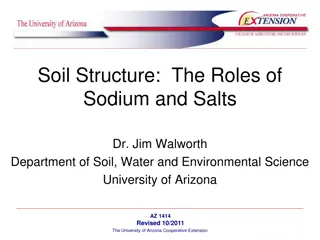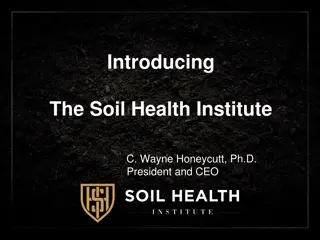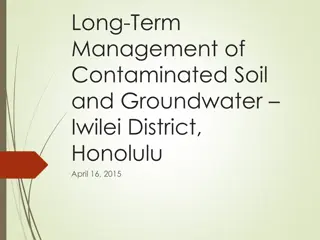Understanding Soil Behavior and Formation in Civil and Environmental Engineering
Civil and environmental engineering heavily rely on the properties and behavior of soil and rock materials for successful project outcomes. Geotechnical engineering and environmental considerations play crucial roles in dealing with earth materials. This content explores the elemental compositions of Earth's crust, the geologic cycle, and the processes of denudation, weathering, erosion, and deposition in soil formation.
Download Presentation

Please find below an Image/Link to download the presentation.
The content on the website is provided AS IS for your information and personal use only. It may not be sold, licensed, or shared on other websites without obtaining consent from the author. Download presentation by click this link. If you encounter any issues during the download, it is possible that the publisher has removed the file from their server.
E N D
Presentation Transcript
SOIL BEHAVIOUR AND SOIL FORMATION INTRODUCTION 1. Civil and environmental engineering includes the conception, analysis, design, construction, operation, and maintenance of a diversity of structures, facilities, and systems. All are built on, in, or with soil or rock. The properties and behavior of these materials have major influences on the success, economy, and safety of the work. Soils and their interactions with the environment are major considerations. Furthermore, detailed understanding of the behavior of earth materials is essential for mining, for energy resources development and recovery, and for scientific studies in virtually all the geosciences. To deal properly with the earth materials associated with any problem and project requires knowledge, understanding, and appreciation of the importance of geology, materials science, materials testing, and mechanics. Geotechnical engineering is concerned with all of these. Environmental concerns especially those related to groundwater, the safe disposal and containment of wastes, and the cleanup of contaminated sites.
SOIL BEHAVIOUR AND SOIL FORMATION 1.1 The Earth s Crust The continental crust covers 29 percent of Earth s surface. The elemental compositions of the whole Earth and the crust are indicated in Fig. 1. There are more than 100 elements, but 90 percent of Earth consists of iron, oxygen, silicon, and magnesium. Less iron is found in the crust than in the core because its higher density causes it to sink. Silicon, aluminum, calcium, potassium, and sodium are more abundant in the crust than in the core because they are lighter elements. Oxygen is the only anion that has an abundance of more than 1 percent by weight; however, it is very abundant by volume.
SOIL BEHAVIOUR AND SOIL FORMATION Silicon, aluminum, magnesium, and oxygen are the most commonly observed elements in soils. Fig.1 Elemental composition of the whole Earth and the crust (percent by weight)
SOIL BEHAVIOUR AND SOIL FORMATION 1.2 Geologic Cycle and Geological The surface of Earth is acted on by four basic processes that proceed in a never- ending cycle, as indicated in Fig. 2. Denudation includes all of those processes that act to wear down land masses. These include landslides, debris flows, avalanche abrasion, and overland flows such as rivers and streams. Weathering includes all of the destructive mechanical and chemical processes that break down existing rock masses in situ. Erosion initiates the transport, wind Fig. 2: Geological Cycle
SOIL BEHAVIOUR AND SOIL FORMATION transportation of weathering products by various agents from one region to another generally from high areas to low. Weathering and erosion convert rocks into sediment and form soil. Deposition involves the accumulation of sediments transported previously from some other area.
SOIL BEHAVIOUR AND SOIL FORMATION 1.3 Soil Formation Soil is defined as sediments or other accumulation of mineral particles produced by the physical or chemical disintegration of rock, plus the air, water, organic matter, and other substances that may be included. Soil is typically a non-homogeneous, porous, and earthen material whose engineering behavior is influenced by changes in moisture content and density. To understand and appreciate the characteristics of any soil deposit require an understanding of what the material is and how it reached its present state. This requires consideration of rock and soil weathering, the erosion and transportation of soil materials, depositional processes, and postdepositional changes in sediments.
SOIL BEHAVIOUR AND SOIL FORMATION 1.3.1 In situ, weathering processes lead to a sequence of horizons within soil. Weathering of rocks and soils is a destructive process whereby debris of various sizes, compositions, and shapes is formed. The new compositions are usually more stable than the old and involve a decrease in the internal energy of the materials. A variety of physical, chemical, and biological processes act to break down rock masses. Physical processes reduce particle size, increase surface area, and increase bulk volume. Chemical and biological processes can cause complete changes in both physical and chemical properties. Weathering
SOIL BEHAVIOUR AND SOIL FORMATION 1.3.1.1 Physical Processes of Weathering Physical weathering processes cause in situ breakdown without chemical change. All type of actions that cause a disintegration of the parent rocks by physical means such as, gravity, wind and water. The product of this type is rounded, sub rounded or granular, its products called coarse grained soil e.g. (gravel and sand ) they present in nature in a single grain structure(which are cohesion less and they have the same properties of the parent rock) .
SOIL BEHAVIOUR AND SOIL FORMATION 1.3.1. 2 Chemical Processes of Weathering All types of chemical reactions that occur between the minerals of the rock and the environment (air, water ---et.) and will end up by disintegration of parent rock into fine grain particles; these products have different properties from the parent rock. Chemical weathering transforms one mineral to another or completely dissolves the mineral. Practically all chemical weathering processes depend on the presence of water. Hydration, that is, the surface adsorption of water, is the forerunner of all the more complex chemical reactions, many of which proceed simultaneously. Its products called coarse grained soil e.g. (silt and clay), which are cohesive materials, and its properties do not reflect the same properties of the parent rocks.
SOIL BEHAVIOUR AND SOIL FORMATION 1.4 Soil Origin The origin of soil can be broken down to two basic types: residual, and transported. The properties of each of one as follow: Residual soil 1- (decomposition) of rock by chemical or physical action. Is caused by the weathering
SOIL BEHAVIOUR AND SOIL FORMATION 2- Residual soils may be very thick in areas of intense weathering such as the tropics, or they may be thin or absent in areas of rapid erosion such as steep slopes. 3- They are usually clayey, and their properties are related to climate and other factors prevalent at the location of the soil. 4- Residual soils are usually preferred to support foundations, as they tend to have better, more predictable engineering properties
SOIL BEHAVIOUR AND SOIL FORMATION Transported or deposited soils 1- They are derived by the movement of soil from one location to the other by natural means such as wind, water, ice, and gravity. 2- The character of the resulting deposit often reflects the modes of transportation and deposition and the source material for example deposits by water include alluvial floodplains, coastal plains, and beaches, deposits by wind include sand dunes and loess, and deposits by melting ice include glacial till and outwash.
SOIL BEHAVIOUR AND SOIL FORMATION 3- Each characteristics dependent on geological origin, and the geological name, such as loess, conveys much useful information. of these materials has behavioral 4- Transported soils particularly by wind or water are often of poor quality in terms of engineering properties.
SOIL BEHAVIOUR AND SOIL FORMATION 2. SOIL MINERALOGY Soil is composed of solid particles, liquid, and gas and ranges from very soft, organic deposits through less compressible clays and sands to soft rock. The solid particles vary in size from large boulders to minute particles that are visible only with the aid of the electron microscope. A soil may contain virtually any element contained in Earth s crust; however, by far the most abundant are oxygen, silicon hydrogen, and aluminum. These elements, along with calcium, sodium, potassium, magnesium, and carbon, comprise over 99 percent of the solid mass of soils worldwide.
SOIL BEHAVIOUR AND SOIL FORMATION Mineralogy is the primary factor controlling the size, shape, and properties of soil particles. These same factors determine the possible ranges of physical and chemical properties of any given soil; therefore, a priori knowledge of what minerals are in a soil provides intuitive insight as to its behavior. Commonly defined particle size ranges are shown in Fig. 3. The divisions between gravel, sand, silt, and clay sizes are convenient. Particles smaller than about 200 mesh sieve size (0.074 mm), which is the boundary between sand and silt sizes, cannot be seen by the naked eye. Clay can refer both to a size and to a class of minerals. As a size term, it refers to all constituents of a soil smaller than a particular size, usually 0.002 mm (2 m) in engineering classifications
SOIL BEHAVIOUR AND SOIL FORMATION Figure 3: Particle size ranges in soils


